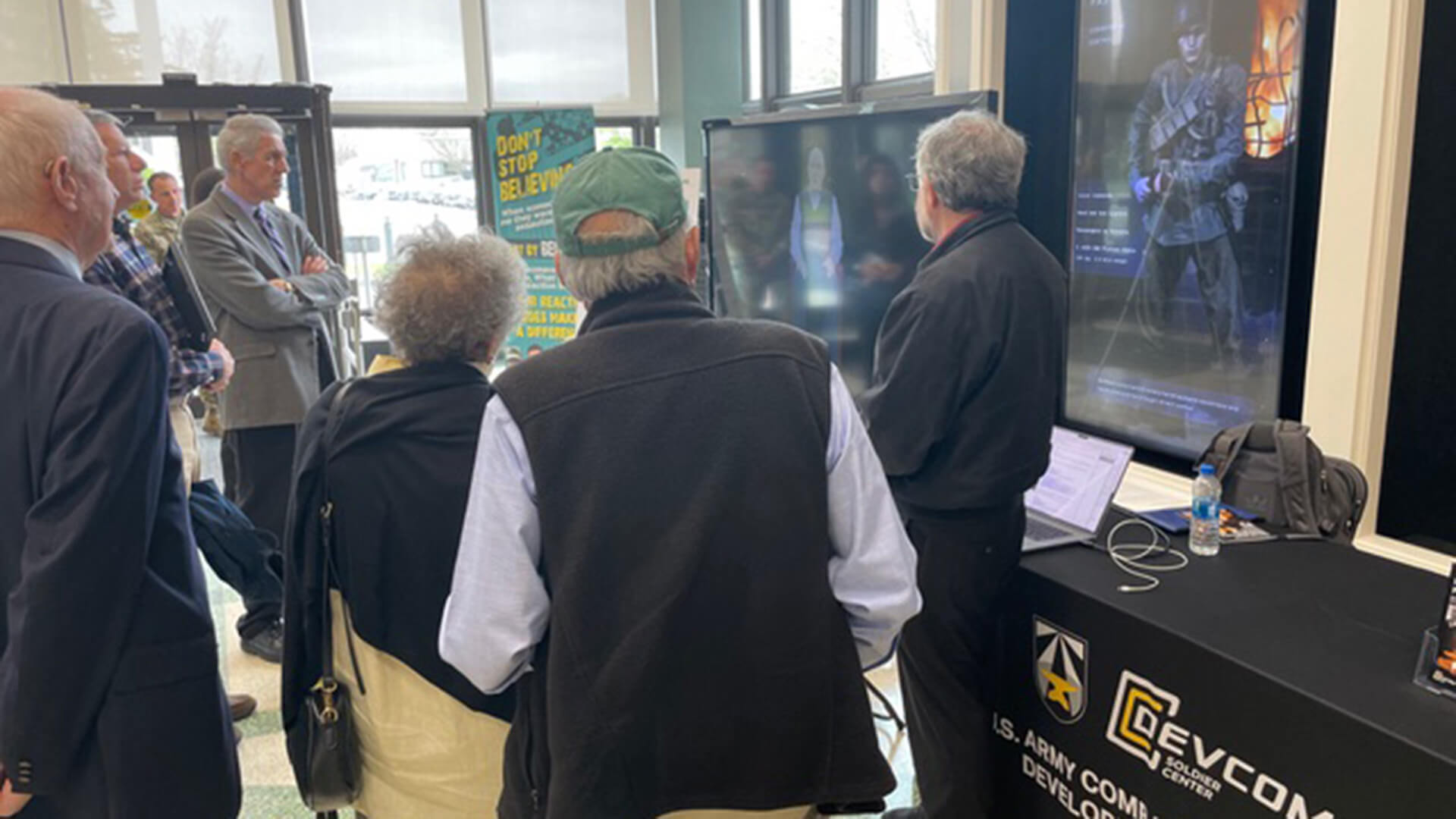As covered in Army.mil, at the DEVCOM Soldier Center (SC) Holocaust Remembrance Program, ICT’s Dr. David Traum, Director for Natural Language Research, demonstrated New Dimensions in Testimony, new technology that allows us to preserve for future generations much of the experience of conversing with a Holocaust survivor that we have today at events like these. Hearing Holocaust survivors describe their experiences can be incredibly moving. Yet, as years have passed, comparatively few survivors remain to give testimony to their lived experiences. ICT Research into Natural Language Processing (NLP), including fundamental research supported by the Army through DEVCOMʼs Simulation and Training Technology Center (STTC) has allowed us to address that problem.
New Dimensions in Testimony (NDT), allows people to converse with the “PersonAIge” of a Holocaust survivor, as if the survivor is there in the room with them. The “PersonAIge” uses AI and NLP software to understand spoken or typed questions and select from a large set of recorded responses from the survivor, and play the response in real time. “PersonAIge” is a term used by ICT to refer to the construct you are talking to as opposed to the real person whose recordings it includes. It’s almost the opposite of an “avatar” (where the individual controls a different body), and not a “hologram” (because it might use different display technology which might not even be 3D), so there wasn’t really a good word to use. A “PersonAIge” is like a person but with AI inside.
NDT thus turns a passive experience of watching video testimony into an active process of inquiry and conversation. NDT, also called Dimensions in Testimony (DiT), is a collaboration between the USC Shoah Foundation and the USC Institute for Creative Technologies, with concept by Conscience Display. NDT involved an intensive interview process, where survivors were asked both general questions about the Holocaust and their life and views as well as specific questions focused on their unique experiences. Survivors were recorded using ICT’s Light Stage technology with multiple cameras for high-fidelity playback and future-proof 3D experiences. Additional training data from early users supports machine learning algorithms to understand and respond engagingly to a broad range of questions and other conversation.
New Dimensions in Testimony is now widely used within educational institutions and museums around the world, including permanent exhibits at the Illinois Holocaust Museum and Education Center and the CANDLES Holocaust Museum and Education Center. Years from now, long after the last survivor has passed on, NDT can provide a path to enable young people to listen to a survivor and ask their own questions directly, encouraging them, each in their own way, to reflect on the deep and meaningful consequences of the Holocaust. The project also advances the age-old tradition of passing down lessons through oral storytelling, but with the latest technologies available.
According to Dr. David Traum, the Holocaust Remembrance Program, which took place at SC’s Massachusetts facility at the U.S. Army Natick Soldier Systems Center, or NSSC, was well attended, and included soldiers in uniform, scientists, and others from the local community. SC Scientists work in a wide variety of areas, including uniforms, food, and parachute delivery. Community members included local residents and others who came in for the event from out of state.
“The main speaker, Kurt Linden talked about Jews in Germany before the war, and how his familyʼs distinguished German Army service meant nothing to the Nazis, leading up to Kristellnacht and beyond,” said Dr. David Traum. “He told of how his father brought the family to Shanghai, the only place at the time that would take jews without a passport, and how the Jewish community grew to over 10K people for about 10 years, and then dispersed with the coming of the communists. Both he and the Rabbi made compelling observations of how poignant such a remembrance is today given the recent rise in antisemitism.”
After the main speaker, Dr. Traum demonstrated NDT, giving participants an opportunity to ask their own questions and hear Holocaust survivor Pinchas Gutter respond to them directly.
“The participants were very enthusiastic, with more than one fighting back tears, and others commenting that it seemed like ‘magic’,” reported Dr. Traum.
“This is a terrific example of a series of dual use technologies, with both public and private funding, serving both the military and nation,” said Dr. Brawner, the ICT UARC Program Manager based in Orlando, which is scheduled to finish construction on its own Holocaust Museum in 2026 and will have an NDT system deployed.
//
